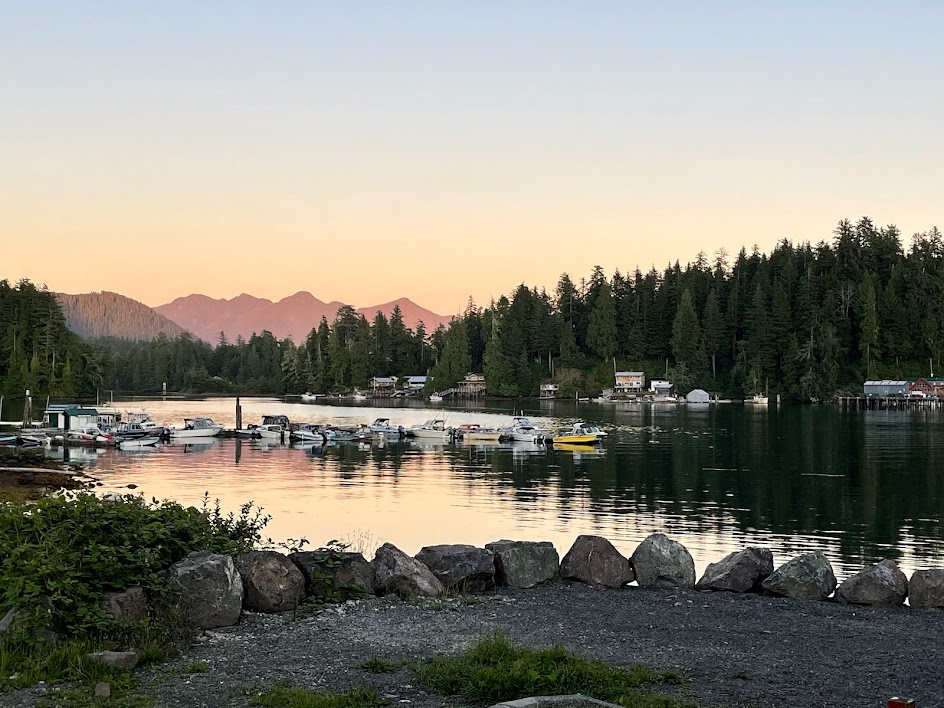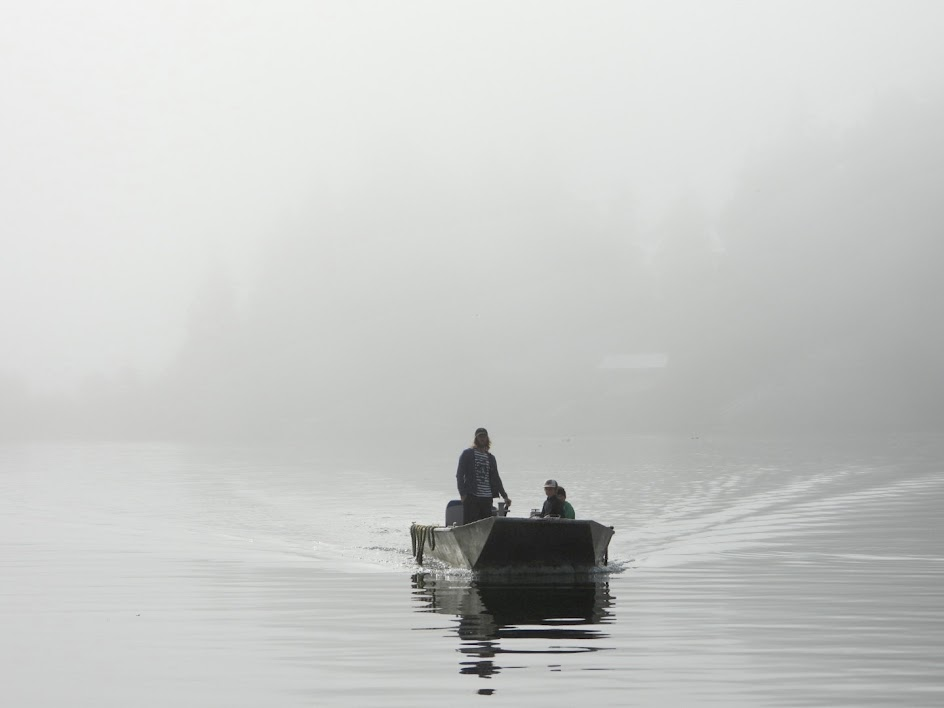Kyuquot First Responders: A model for remote EM Care in BC.
Perspectives from medical trainees.
By Lewis Forward and Jonah Latsky, Kwiis hen niip Project.
About the Authors
Lewis Forward is a fourth-year medical student of European settler descent, living and working in Kingston/Katarokwi on the traditional lands of the Haudenosaunee and Anishinaabek.
Jonah Latsky is a Family Medicine resident of European settler descent, living and working in rural Alberta on the traditional lands of the Blackfoot Confederacy First Nations, the Tsuut’ina First Nation, and the Stoney Nakoda peoples.
Kyuquot (Ka:yu:’k’t’h’ / Che:k’tles7et’h’ First Nations) is a Nuu-Chah-Nulth community on the west coast of Vancouver Island, flanking a narrow rocky harbour, accessible only by boat or helicopter when the weather of the open Pacific allows.
Eagles perch on dock pilings, and the rumble of outboard motors accompanies residents heading to work. Across the water from the main town, Houpsitas, is a small nursing station staffed by a lone remote nurse. Kyuquot’s school sits on high ground beside a shipping container filled with tsunami emergency supplies in case the sea washes over the village again.
In Kyuquot, all emergency care is provided by a small team of volunteer community First Responders and the nurse. During the early pandemic, there were three main First Responders who were on 24/7 call. Their ranks have since grown to five, but recruitment is challenging with no pay, high call volume, and limited training opportunities.
In Kyuquot, all emergency care is provided by a small team of volunteer community First Responders and the nurse.
In their homes, First Responders keep a neon-green duffel bag equipment kit to provide care to their neighbours, friends, and family members. In a community of 190, strangers are rare.
In this setting, Kyuquot’s providers have created a unique and informative model of responsive, community-driven care provision in their remote setting.
In July 2021, First Responders, Nursing, medical learners, Kwiis hen niip staff, and an implementation science expert met in Kyuquot to discuss plans for further improvements to emergency care delivery. Projects like this defy traditional, urban-centric models of quality improvement. Evidence-based interventions may not be relevant to a community’s unique cultural, geographical, historical, and social contexts. The purpose of this meeting, and the broader Kwiis hen niip project, is to see, listen, and to support community-informed interventions that work in the local context.
During the visit and throughout the ongoing Kwiis hen niip partnership process, Kyuquot’s First Responders- along with First Responders in three other Nuu Chah Nulth communities- made clear calls for how First Responder care in settings like theirs can be better supported.
… Kyuquot’s First Responders – along with First Responders in three other Nuu Chah Nulth communities – made clear calls for how First Responder care in settings like theirs can be better supported.
When callouts require transport to larger centres, complex coordination is required between First Responders and nursing, BCEHS, local water taxis and boat owners, and the eventual referral centre. In the rare instances when weather conditions and air ambulance availability align, transport time is measured in hours. If visibility is low, airlift isn’t available, or seas are high, out-of-community care can be delayed by days.
A local water taxi operator told us that during winter months, he may only have ten days a month which allow safe transport. On a clear, windless day in July, It took our team five hours to reach Kyuquot from Courtney, via Fair Harbour. The next day, a thick wall of fog rolled in.
If visibility is low, airlift isn’t available, or seas are high, out-of-community care can be delayed by days.
When people are transported out, their family members may be unable to accompany them – a tension that worsened during the pandemic. If they follow by boat, then car, they face significant out-of-pocket expenses for transportation and accommodation. In practice, this means many people from Kyuquot navigate this journey alone. In out-of-community care settings, knowledge and practice of cultural safety varies significantly. Experiences of isolation and racism are common.
Community members are currently advocating for more helicopter availability, self determination when it comes to which hospitals they are transported to, and to facilitate accessibility for support persons, and post-discharge transport.
Geography requires Kyuquot’s First Responders to operate at the furthest extent of their scope of practice, maximizing the benefits of the rare training accessible in their context. They learn from each call and teach each other, and themselves, as much as possible. Formal training varies from provider to provider. One has an Emergency Medical Responder certification, and the rest have Occupational First Aid, Marine First Aid, or CPR-C.
In response to calls for training, Kwiis hen niip has enabled Emergency First Responder training in Courtenay for First Responders from all four participating communities, including Kyuquot, with full travel, accommodation, and program funding provided by the BC First Nations Health Authority.
In response to calls for training, Kwiis hen niip has enabled Emergency First Responder training in Courtenay for First Responders from all four participating communities
Challenges remain. First responder training specifically tailored to Kyuquot’s circumstances does not exist. Courses are only available outside of Kyuquot, which requires volunteers to travel, take time off work, and fund expenses. Most First Responders work more than one job: in local government, in the fishing or tourism industries, or in organizing emergency response coordination for fire and other disasters. This makes travel for additional training challenging.
The Kwiis hen niip project is addressing the need for in-community training in collaboration with the Nuu-Chah-Nulth communities, BCEHS, Heart and Stroke, FNHA, BC EM Network and the UBC Department of Emergency Medicine. This includes the “train-the-trainer” model in which local First Responders provide training to other First Responders and community members.
The reasons behind First Responders’ requests for in-community training became more obvious as we were shown the ways that urban, one-size-fits-all training approaches would fall flat in Kyuquot’s context. The urban programming lens uses processes and algorithms that rely on resources like rapid EMS response and access to hospitals, which are irrelevant in Kyuquot, limiting their utility.
Kyuquot’s First Responders have a lot of experience providing skilled care in a limited setting, but they are hamstrung by transport issues, supplies, and access to training. As the pandemic stretches on, this has left many of them feeling burnt out.
After emergencies, Kyuquot’s providers debrief with each other, but they do so cautiously. Privacy is hard to maintain in a place this size. Some First Responders visit hereditary bathing pools and brush with cedar and spruce. A sweat lodge is under construction.
Students’ Role in Reconciliation
Involving medical students and residents in remote Indigenous health care research
As medical trainees, the recent trip to Kyuquot was an eye opening experience. It was immediately humbling to see how soon we would reach the limit of our formalized, western, tertiary-centre based medical training in their context. When their radios chirp, responders sling the neon bags on their backs and attend workplace accidents, pediatric emergencies, time-sensitive neurological and cardiac emergencies – all types of medical crises that can be imagined in a remote coastal town.
As providers, it is crucial to recognize that out-of-community expertise and quality improvement initiatives will fail unless fully informed by the local experiences and context of the community. Successful interventions should be led by local providers who understand care provision in their context better than anyone.
We have been privileged to be involved in this project, learning and working with the Nuu-Chah-Nulth peoples. As we strive to improve various CanMEDS abilities essential to our role as future physicians, working with remote Indigenous communities provides an opportunity to collaborate with Indigenous and remote partners, communicate with improved contextual awareness and cultural competencies, and advocate at various levels alongside the community.
Involvement of learners with a community can be harmful if not done with an anti-colonial focus. A medical student on the Kwiis hen niip team, Sarah Douglas, published an excellent article titled ‘A method of facilitating medical student engagement with local Indigenous communities‘ (S. Douglas, C. Cleversey, and A. Ram, 2020). It highlights the importance of Indigenous leadership and community-driven decision-making in learner involvement. With these principles implemented, we feel medical learner involvement in remote Indigenous communities can contribute towards reconciliation.
Reflecting on the Truth and Reconciliation Commission (2015) results, several calls to action are directly implicated in the project’s work, and the involvement of medical learners. Collectively we need to promote the number of Indigenous professionals working in the health care field, ensure the retention of these providers in Indigenous communities, and ensure cultural competency training for all health care professionals. Many of the calls to action are directed towards the government, and the physician’s responsibility as an advocate is essential to help bring these calls to fruition.
About the Kwiis hen niip Project
Kwiis hen niip – “Change for emergency care services in rural and remote Indigenous communities in BC”, is a partnership with the Nuu-Chah-Nulth Tribal Council (NTC), the Heart and Stroke Foundation (H&S), the BC Emergency Medicine Network (EM Network), UBC Department of Emergency Medicine, Indigenous researchers and community members. The project aims to improve access to emergency services in four remote Nuu-Chah-Nulth communities on Vancouver Island: Kyuquot, Hesquiaht, Ahousaht and Tla-o-qui-aht. Through ongoing community consultation, multiple priority areas of improvement are identified, including first responder support, patient transport, communications and community readiness.
Learning Resources
- Update on Kwiis hen niip Partnership (BC Emergency Medicine Network)
- Reconciliation Canada
A non-profit group promoting understanding of the Canadian Indian residential school system. - Personal Acts of Reconciliation (CBC)
10 actions you can take to learn more about reconciliation - San’yas Indigenous Cultural Safety Training
Online Indigenous Cultural Safety course developed by PHSA, free to practitioners with health authority emails. - Indigenous Cultural Safety Collaborative Learning Series
Webinar Series: Setting the Context for Indigenous Cultural Safety: Facing Racism in Health - Cultural Safety and Anti-Racism in Healthcare: How can Emergency Medicine Contribute?
Webinar hosted by EM Network Members Kendall Ho and Dan Kalla - Indigenous Health in the ED: The Role of Implicit Bias
Webinar presented by EM Network Member James Liu
COMMENTS (0)
Add public comment…




POST COMMENT
We welcome your contribution! If you are a member, log in here. If not, you can still submit a comment but we just need some information.